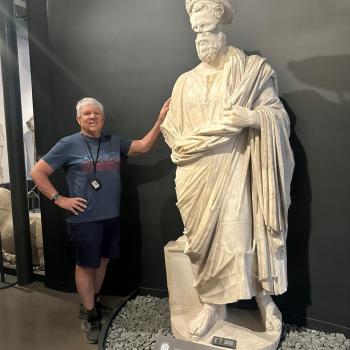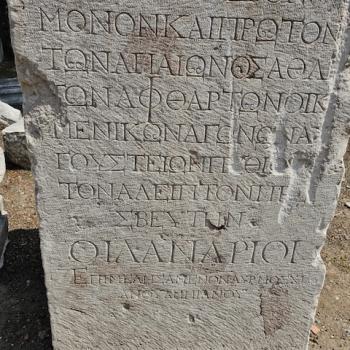Dr. James Charlesworth is a distinguished member of the faculty at Princeton, and a fellow United Methodist in connection with the Western N.C. Conference. Jim is a friend and I have known him for years, and asked him to do a little Q and A to help clear up some of the misconceptions about the ‘Patio’ or Talpiot B tomb. I think you will find it enlightening. It reminds us that archaeological evidence is often quite ambiguous and equally good scholars can come to different, even diametrically opposite conclusions about the same subject.
———-
Q. Professor Charlesworth you were consulted in regard to some of the apparent scripts on the Jewish ossuaries found in Talpiot Tomb B. How exactly did you come to be involved in this project?
A. First, thanks Ben for inviting me to share my thoughts for the first time. I have been cited only by Journalists who abbreviate any comment; that is their profession and right. Also, a full report will be posted this week in www.FJCO-DSS-Events.org. I supply picture there.
When I was living in Israel in the summer of 2011, I was invited to see what had been discovered by exploring a tomb un-intrusively via a specially constructed robotic arm with cameras.
Q. Here is the quotation from the press release, in which you seem to be credited with coming up with the idea that the name Jonah appears in the stick figure (if that’s what it is) on this ossuary. “This discovery by Prof. Charlesworth is quite remarkable and had been overlooked in our initial analysis,” noted Tabor. “The engraver has apparently rather ingeniously combined what we took to be the stick-figure of Jonah with the four Hebrew letters spelling out his name.” My question is— did you first suggest this idea, or did someone suggest it to you? In other words— is this attribution of the idea to you correct?
A. The attribution to me is correct. On my web site, I show images that prove that the nun is one continuous stroke. Other images have misled some fine scholars.
Q. What is your position on the notion that Talpiot Tomb B is actually the tomb of Joseph of Arimathea?
A. I am not convinced. We know too little about this figure who looms so large in our beloved Scriptures.
I have been convinced that the tomb of Joseph of Arimathea was near the site pointed out as Golgotha since before 350 CE. It is in the Church of the Holy Sepulcher which as clearly outside the walls of Jerusalem in 30 CE, as proved by Jewish tombs in situ and with wooden roofs now (on the floor).
I think we should avoid the term “impossible.” Let us listen to any informed reflection.
Q. Do you think that the discoveries in Talpiot Tomb A or B have anything to do with the burial of Jesus of Nazareth?
A. I find that difficult to believe. My position appears in The Tomb of Jesus and His Family? Exploring Ancient Jewish Tombs Near Jerusalem’s Walls. Eds. James H. Charlesworth and Arthur C. Boulet. Grand Rapids: Eerdmans, 2012 (expected publication date is 15 Oct 2012).
I find it difficult to imagine that Jesus’ bones would have been put in an ugly ossuary with a name that was scribbled so crudely that “Jesus, son of Joseph” would have to appear in any sophisticated work with dots over “Jesus” to signal that the name is a guess. If Jesus’ bones were still on earth one year after his resurrection, they would have been collected and honored by Jews who hailed him as the Messiah, the Christ.
Let us not forget that the great Professor Eleazar Lipa Sukenik found in a warehouse an elegant ossuary with this clear marking: “Jesus, son of Joseph.”
Those names were as popular as “John” and “James” today; moreover, we must admit to the existence of at least two men called “Jesus, son of Joseph,” as there are two separate bone boxes.
Q. Do you agree or disagree with the notion that Jews did not use ossuaries for burials after A.D. 70? What about the ossuaries at Dominus Flevit that seem to be Christian ossuaries from the second century?
A. It seem clear now that Jews ceased to use ossuaries near Jerusalem after 70 CE. Can we have a decent and informed discussion about the ossuaries at Dominus Flevit? What do we learn from them, and would preconceived ideas hinder open reflections?
Q. Various scholars have suggested that the object on the ossuary that is called a fish in the Discovery Channel special is actually a nephesh or an amphora? Why do you think it is a fish? Why do you suppose it has the peculiar orientation it does– with the apparent head of the fish pointing down to the bottom of the ossuary, since this does not seem to comport with the Jonah story or Jesus’ use of it?
A. Description: First, it is imperative to realize the image is something inscribed by an unskilled hand on limestone. The inscriber did not use a ruler or compass; he seems to have used only a chisel and hammer. He thus produced a poorly incised ornamentation by freehand. We should expect that type of work in and around Jerusalem in pre-70 strata, since Jews were prohibited, and thus had no skills, to depict any likeness in God’s creation (recall the Commandment). There was also probably no workshop or skilled artisans to help him; and perhaps the image was made without sufficient time.
The long and concave figure is approximately 23 cm. long and approximately 15 cm. wide at the greatest extremity (the curved bottom that is at the top) or 9 cm near the appendixes.[i] The figure comes to a point on one end and fans out on the opposite end. At the pointed end is a circular shape about 3 cm in circumference. On each side of the figure are lines that appear to be appendages. In the center of the figure are three lines. The section closest to the tip contains square markings while the other two contain triangular lines. Halfway between the appendages and the tip is a section that contains numerous lines drawn at different angles. A series of horizontal lines running perpendicular to the main figure run across the sphere at the bottom. What could this image symbolize or is it just a sign? That is, is the drawing a sign or a symbol? A sign can mean one and only one thing; a good example is the stop sign. All know where to stop. A symbol must be interpreted and usually has many meanings. Symbols appear in a world of ambiguity and bring with them more than one meaning.
A Nefesh (a tomb monument that signals the “soul(s)” entombed). Looking at the image on an unpublished ossuary in Rahmani’s Catalogue of Jewish Ossuaries, it is easy to imagine the image is a nefesh. In both drawings, the “bottom” is concave. Some images of a nefesh do have something on the sides like spirals. The experts who were studying the Patio Tomb identified a nefesh on one ossuary but concluded this image was not a nefesh. Yet, it is conceivable that the drawing is a nefesh; after all we should admit the drawing is crude. One problem with the assumption that the image is a funerary monument is that it would be up-side-down, with the base at the top. Does that seem likely?
An Amphora. The image does appear in some ways like an amphora. It is rounded and has a top. The image has something on each side. Could these be handles? If so, they are not like any known handles on an amphora, whether drawn or part of an amphora itself. Is it possible that retinal retention has elicited these attempts to discern the meaning? If one looks at an amphora, one can easily see this image as an amphora. But, is that what the engraver intended? The oval-shaped bottom of the drawing seems too rounded for the base of an amphora. The handles, moreover, are oddly shaped and unlike any on an amphora. Many artisans depicted amphora correctly on ossuaries, why is this image so unlike others?
Any attempt to enter the mind of an engraver in order to discern the intention of an “artist” borders on unsophisticated methodology, frequently speculating with unexamined presuppositions. To discern what it might mean to a viewer is another matter. Both of the attempts so far rightly assume that ossuaries exist with a drawing of a nefesh or an amphora.
A Fish. If this is a fish, it seems crudely drawn and depicted downward. It may well be a fish, if one imagines an unsophisticated attempt. The shape does seem reflective of a large fish. The head appears pointed and expands outward towards the center and then slopes inward and down to an elongated “tail.” That contour is “fishlike.” The tail seems concave like the tail of a fish; it is well drawn but the appendages are poorly indicated. Could they be a crude attempt to depict the flippers on a big fish? Had the “artist” ever seen a large fish? If this is a drawing of a big fish, where is the eye and where is the mouth? Perhaps the mouth is at the point near “the bottom,” and the eye is a barely visible circle to the left of the “mouth.” We will need better images to prove what some see as a mouth and an eye (but many images of fish have no eye).
Fish do appear on ossuaries; Rahmani reported that Ossuary 348 had a mark that “seems to represent a fish.” Is this another example of a fish and if so does it merely mean that the one whose bones are inside the ossuary was a fishmonger? According to Nehemiah 13:16, men came to Jerusalem from Tyre (on the coast north of Acco) with “fish” to sell. Rahmani is convinced that the circle on Ossuary 140 around “Yeshua‘” (“Jesus”) is only coincidentally “a fish.” Is that discussion closed?
Why has the engraver spent so much time on the lines within the spherical “bottom”? One can count at least 14 strokes. Why? What was imagined?
It is easy to dismiss the suggestion that someone tried to draw a large fish. The middle section with squares needs explanation. And one should be willing to imagine that the image is really an amphora. Staring at it for long periods can convince one it might be a crude attempt at a nefesh. But, something is intended. We should move beyond what it could possibly be and ask what is the intentionality that created this image?
All attempts have so far failed to explain why the drawing is upside down. If the Jewish engraver who made this etching had Jonah in mind, then perhaps some answers are forthcoming. According to the biblical author, Jonah was spat out by the “large fish” unto dry land (Jonah 2:11); that could be depicted by placing a fish upside down. Any other angle would mean that “Jonah” was shot into the air.
Q. Let us suppose for the sake of argument that there is a fish on that ossuary, and it does have the word Jonah on it. Would this suggest to you some connection with Jesus of Nazareth, or rather with an early Jewish Christian follower of Jesus who is in hopes of a resurrection like Jonah and Jesus’? In other words— would the symbolism be a comment on a past resurrection of the one interred, or a hoped for future resurrection of the person whose bones were in that box since the use of the Jonah image in the Roman catacombs is always about a future hoped for resurrection of the deceased?
A. Do not forget the clear inscription that I translated as referring to YHWH raising up someone.
What type of Jew would have made this inscription and the drawing?
A resurrection belief was shared by many early Jews, representing various groups or sects. As I showed in Resurrection: The Origin and Future of a Biblical Doctrine, resurrection belief means that someone who lived and has died will be raised by God to an eternal existence with God.The belief in a resurrection may be found in some Davidic Psalms, but the first lucid (or un-debatable) reference to it appears, perhaps around 200 BCE, in the Books of Enoch (1 Enoch). Then chronologically, the concept appears in Daniel 12. At Qumran, in a document probably not composed at Qumran, the belief clearly appears in On Resurrection (5Q521) and in Pseudo-Ezekiel 54Q385-388). In many works of Early Judaism the belief in a resurrection is evident, including Josephus’ compositions, the Psalms of Solomon, the Life of Adam and Eve, 4 Ezra, 2 Baruch, 2 Enoch, the History of the Rechabites, the Lives of the Prophets, 1-4 Maccabees, Pseudo-Philo, the Apocryphon of Ezekiel, Pseudo-Phocylides, Sibylline Oracles, the Testament of Abraham, the Testament of Job, the Testaments of the 12 Patriarchs, the Apocryphon of Ezekiel, and the Odes of Solomon. The belief in the resurrection is also found in the Didache, the Hellenistic Synagogal Prayers, and the Amida or 18 Benedictions. According to Hippolytus (but not Josephus), the Essenes believed in the resurrection of the flesh (Haeresies 9.27).The Samaritans believe that God will summon “his creatures” so that all of them will “arise in one moment before him (Memar Markah 4.12; cf. also Yom ad-Din 26). Moreover, the concept of a bodily resurrection created and defined the Palestinian Jesus Movement; according to Paul if Jesus was not raised by God then “our proclamation is in vain and your faith is in vain” (1Cor 15:14). Without any doubt, the concept of resurrection (far more than a belief in a coming Messiah) brings into perspective the shared beliefs and hopes within Early Judaism.
Are the inscription and the drawing not to be perceived within Jewish resurrection beliefs? It is as absurd to dismiss the possibility that this tomb has some relation with the Palestinian Jesus Movement as to claim that it clearly must be labeled a “Christian” tomb. Emotions are too enflamed by such unscholarly outbursts.
Finally, we Christians do not need any proof or support for our commitment to God through Jesus Christ, but we should find inviting the enlightening reflections in windows provided by the Talpiot Patio Tomb. Through them, we may see more clearly the world that shaped the lives and beliefs of luminaries like the Righteous Teacher, Hillel, John the Baptizer, Jesus, Peter, Gamaliel, Paul, and Stephen. What are we now learning about Jewish resurrection faith before the burning of the Temple in 70 CE?













